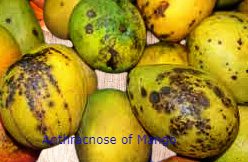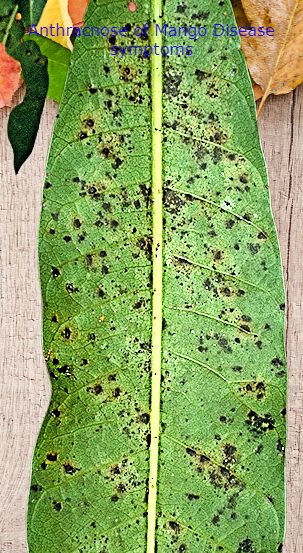Anthracnose of Mango
Anthracnose of mango is a fungal infection. The fungus Colletotrichum causes mango anthracnose disease. An alternative term for mango blossom blight is anthracnose. This fungal disease is more prevalent when the weather is humid. Because the spread of anthracnose sickness is facilitated by rainfall. The signs of anthracnose emerge on leaves, stems, flowers, and fruits.
Anthracnose of Mango Disease History
Anthracnose is a common and destructive disease that affects mango trees (Mangifera indica) worldwide. It primarily targets the fruit, leaves, and flowers of the mango tree. Here’s a brief history of anthracnose of mango disease.
Early Observations
Mango anthracnose has likely been a problem for mango growers for centuries, but formal scientific documentation began in the late 19th and early 20th centuries. Researchers and horticulturists started studying the disease and its impact on mango crops.
Scientific Description
The disease was formally described in scientific literature, and its causal agent, Colletotrichum gloeosporioides, was identified. This fungus is responsible for most cases of mango anthracnose.
Spread and Impact
Anthracnose of mango became a significant concern in regions where mango cultivation is a primary industry, such as South Asia, Southeast Asia, and parts of the Americas. It is known for causing severe losses in mango production due to fruit rot and leaf damage.
Control Measures
Over time, researchers developed various strategies to manage and control anthracnose. These strategies include the use of fungicides, cultural practices like pruning and sanitation, and breeding for resistance in mango cultivars.
International Research Efforts
As the disease continued to impact mango production globally, international organizations, agricultural research institutions, and universities collaborated on research projects to find effective solutions for managing anthracnose.
Disease Management
Integrated disease management approaches have been developed to mitigate anthracnose’s impact. These strategies aim to combine cultural, chemical, and biological control methods to reduce disease severity.
Impact on Trade
Anthracnose can affect the export of mangoes from affected regions. International phytosanitary regulations often require strict controls to prevent the spread of the disease through infected fruit.
Ongoing Research
Research into anthracnose of mango continues, with scientists seeking to improve disease resistance in mango varieties, develop more effective fungicides, and refine cultural practices for disease prevention.
Today, anthracnose remains a significant challenge for mango growers worldwide, and ongoing efforts are directed toward finding sustainable and effective solutions to minimize its impact on mango production and trade.
Mango Anthracnose Symptoms


Manifestations of mango anthracnose Massive quantities of bacteria proliferate in the affected regions, and the rain spreads these pathogens to nearby leaves, flowers, and buds. Consequently, these fungi infect leaves and fruits and increase the number of spots. Young, delicate leaves are more susceptible to illness. Initially, these spots are little and black; later, they grow into large, lifeless spots that eventually dry up and fall off. Fungus bacteria on the fruit continue to exist as punctiform infections until the fruit is ripe and suitable for consumption, at which point the infections morph into dark brown to black spots with masses of orange-pink spores.
When the sprouting of new mango leaves coincides with heavy precipitation, the leaves are particularly susceptible to infection. On these young leaves, lesions emerge as tiny brown to black specks (above), which develop into chlorotic halos over time. Lesions tend to cluster near the leaf margins of mature, fully expanded leaves; they are dark brown, irregular in shape, and lack distinct vein delimitation.
In normal conditions, the lesions can remain tiny, but in humid environments, they can spread and cause leaf blight. Anthracnose after harvest manifests as irregularly shaped brown or black lesions on the fruit’s surface. Lesions are uncommon in larger fruit infected by pathogens. The fungus inhabits the fruit but does not become active until the fruit is ripe. On the growing fruit, a dark, depressed, spherical lesion forms and swiftly grows in size.
Anthracnose of Mango Disease Cycle
Rain or irrigation water splashes passively disperse the pathogen’s spores (conidia). Spores are disseminated to possible infection sites during inoculation (panicles, leaves, branch terminals). Infection and the growth of pathogens occur when spores germinate on immature fruits and young tissues, pierce the cuticle and epidermis, and eventually branch out into the remainder of the tissue. Infections are able to penetrate ripe fruits via the cuticle, but they will remain latent until climacteric fruits begin to ripen. On the surface of the damaged organs, the formation of black, sunken, rapidly expanding lesions indicates the progression of the disease. Conidia are produced in fruiting bodies (acervuli) on symptomatic tissue, particularly in moist (rainy, humid) settings, allowing the pathogen to multiply. Multiple disease cycles may arise if the fungus continues to spread throughout the season. During the winter, infected and defoliated ranch terminals and mature leaves might harbor the illness.
Anthracnose Integrated Disease Management
- Site Selection for Orchid
- Post-Harvest Tools Disinfection
- Plant Spacing
- Weed Control
- Fungicide Spray
Anthracnose Treatment
Mango Anthracnose Chemical Control Method
Regular use of fungicide sprays is necessary to keep anthracnose under control on mango trees, especially those cultivated in perfect conditions for the disease. Application time and frequency are critical for optimal illness management. Initial spraying should begin when panicles develop and continue at the prescribed intervals until fruits reach a length of between 112 and 2 inches. Among the permitted foliar fungicides for the control of mango, anthracnose is clarified neem oil, mono- and di-potassium salts of phosphorous acid, chlorothalonil, basic cupric sulfate, copper hydroxide, wettable sulfur, Harpin protein, and copper salts of fatty and rosin acids. Different products function differently and have varying degrees of efficacy. For the chemical control of anthracnose of mango disease, use the fungicide spray of a well-reputed and registered company. Fungicide spray must be used before the rainy season. Before the use of spray read all instructions given on the label.
Anthracnose Disease Cultural Control Method
Trimming the trees through the cultural control method is essential to allow air to circulate freely through the tree canopy to reduce humidity. So trees should be less than 4m tall for easy handling and harvesting. The diseased parts should be removed, and the leaves should be burnt and buried in the soil. Always cultivate varieties that are resistant to the fungus. Because these methods control the Anthracnose of mango trees
- Each year, trees and shrubs should be pruned, and dead leaves and other plant debris should be removed.
- Utilize robust seed strains
- Plants should be separated further apart to prevent catastrophic epidemics.
- Epidemics of mango anthracnose can be slowed by intercropping with disease-resistant trees.
- Do not save plant seeds if this fungus disease is prevalent.
- To prevent the spread of disease, avoid gardens when plants are wet, and be sure to clean gardening tools thoroughly after use.
- To prevent fungal spores from overwintering in garden areas, clean them up in the fall after harvest, and do not compost diseased leaves, fruit, or stems.

